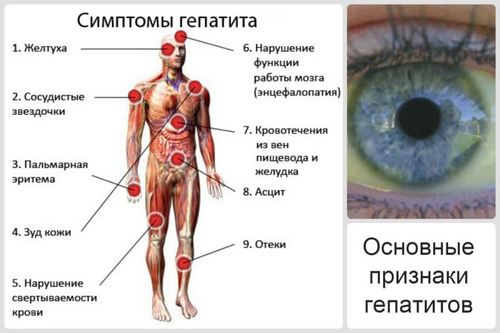Hepatitis is a disease that affects the liver. In medicine it is accepted to classify the types of hepatitis: infectious and noninfectious. This division is more conventional, as for the doctor will find out the main reason which led to the disease.
The main types of hepatitis
Hepatitis is a fairly insidious disease and very often patients are not even aware that they have become a carrier. People hepatitis is also called “jaundice” it is no accident. The person who got this disease, you may observe a yellowing of skin and whites of the eyes.
How do people become infected with hepatitis in humans?
The types of hepatitis are distinguished depending on how they hit the human body and any pathological changes they cause. Some of them are transferred in everyday life. It can be dirty and contaminated food, toys, hands. These forms of hepatitis appear quickly and brightly and are also. In most cases, if the services of professional and timely treatment, it is no threat and serious consequences for the patient’s life arises.
Another kind, called parenteral, often becomes chronic, and the patient lives with it for the rest of their days. The liver of such people is gradually destroyed, which leads to cirrhosis or cancer.

Given such facts, in medicine hepatitis are divided into several types, depending on the mechanism and ways of infection:
- transmitted oral-fecal route. These include hepatitis A and E;
- blood-borne pathogens.
The latter include B, C, D, G. it would be wrong to assume that these species can be transmitted only by blood transfusion. Many of them, especially With and transmitted with the procedures of piercing, tattooing, in the use of drugs during sexual intercourse, from a sick mother to fetus inside her.
As practice shows, the majority of patients in the confirmation of the presence of the virus in the body speculated on where and how an infection has taken place.
What signs should alert?
Symptoms are not immediate, many people live with it for years and not suspect that you are a carrier of a dangerous disease and are a source of danger not only for your health but also your loved ones, friends.
According to some clinical manifestations the patient is able to guess about possible problems with the liver.
These include:
- Fever. This manifestation is more typical of hepatitis A. At the beginning of the activation of the virus, patients feel a slight increase in temperature, there are headache, body aches, bones and muscles.
- Yellowness of the skin. These symptoms can appear from the first days of the disease, and in a few weeks or months. Depending on the varieties of hepatitis, increase the colors will indicate different disease. For the species And the intensity of the color indicates the imminent recovery, and C, alcoholic or toxic – it is a sign of deterioration of the General condition.
- Decreased appetite.
- You may receive a heaviness in the right hypochondrium.
- Patients indicate constant nausea and vomiting.
- Most of the urine becomes dark and the stool light.
By the way, hepatitis, infection which occurs in the home, most often caused by oral-faecal infections. What is the hepatitis, which was received in the home?
Hepatitis a or people it is called “Botkin’s disease” refers to a highly contagious infections. The agent becomes very small virus that has a high demonstrated sustainability and impact on RNA. Once the mechanism of the virus in the liver, the patient experiences common symptoms of intoxication: the temperature rises, there is a weakness, yellowness of the skin. In most cases, the infectious disease is treated and there comes a full recovery and with the acquisition of active and stable immune system.
Classification of household hepatitis also includes the species E, which acts on the RNA level and is propagated in an aqueous environment. Causes of infection in most cases become dirty products, which do not respond to heat treatment. To suffer from this kind of most people who live in the countries of Central Asia and the Middle East.
Hepatitis that are transmitted through blood
Classification of hepatitis that is transmitted through blood, much more.

Some of the known types of take place a long time asymptomatic, and the person does not even know what a peddler is a serious and complex disease.
- Hepatitis C and B.
These are two of the representative who submitted DNA them RNA – containing pathogens. They have a rather complicated structure and affect the liver tissue. To get these viruses, microscopic sufficient dose of the pathogen, so in most cases, infection occurs through sexual intercourse, medical procedures or the vertical path.
These two long time can absolutely not occur. Patients may observe a slight change in the color of urine, a certain heaviness in the region of the liver, but not to make any difference. This is why hepatitis C and is one of the most common according to statistics of the Ministry of health.
- Hepatitis G.
This kind of disease, is the most mysterious and little-studied virus that contains RNA admonitio. The virus has 5 species genotypes, but its structure is very similar to the causative agent of hepatitis C. This species appeared in the West of Africa and then spread around the globe.
Routes of transmission – blood. It is now often found in the hepatitis G and hepatitis B and C as combination that complements and activates each other.
Pronounced symptoms of the disease there. The diagnosis is established during the survey for other diseases.
Hepatitis G may have the following symptoms:
- pain in hypochondrium;
- in rare cases, yellow skin tone;
- may be spider veins, enlarged spleen, weakness throughout the body.
- Hepatitis vols.
This virus is very dangerous as the doctors proved that he can for years to persist in the human body and does not lead to any morphological changes in the liver. People simply function as a carrier without knowing it.
This hepatitis is transmitted through blood transfusion and has even labeled hepatitis TTV. He is one of the newest types that has not been studied in detail. It was first discovered in 1997 in 5 people. How many more people are carriers of this insidious disease is unknown.
The peculiarity of this species is the fact that all blood for transfusion is carefully investigated for the presence of various types of hepatitis, but in practice, this variant gets inside of a person and begins to destroy the liver.
- Hepatitis F.
This species is also one of the newest and still not understood. Hepatitis f learning around the world and try to establish the cause.
On today’s scientists and researchers who study this problem, exchange factors and observations, all these diagnostic studies are rather contradictory.
In most cases, this type occurs in people who have undergone transfusions of contaminated blood. The peculiarity is the fact that when conducting clinical analysis of these patients revealed antibodies to hepatitis A and B, but people after a short period of time suffer these diseases.
The clinical picture is very similar to hepatitis a and b, which affects the liver. But the difference is that when you will be completely amazed by all the cells of the body begin to suffer completely the entire body.
- Toxic hepatitis.
The liver in the body is responsible for a large number of functions, including deactivation and removal of toxins. But there is always the chance of liver damage. Affected cells no longer cope with the function of metabolism, begins the intoxication and may develop hepatitis.
Autoimmune hepatitis
The register also contains a kind of as autoimmune. The reason is incorrect work of the immune system in which your own antibodies affect cells of the liver. The gradual destruction of tissue leads to disorders in the body and the first signs of the disease.
What are the types of hepatitis? What to do in case of first signs of disease development? Of course, to go to the doctor and undergo diagnosis as there is a significant difference in the types of this disease, their course and danger to the surrounding people. Only the conscious understanding of the gravity of this disease will be able to save the patient’s life and everyone around him.



